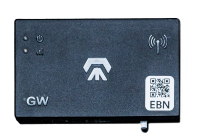








All device connections are outbound, but devices both send and receive data on each connection. Make sure that the following domains and ports are whitelisted in your firewall.
(You must whitelist using the domain, not the resolved IP address.)
%20copy.png)
Once you receive your gateways and make the necessary network updates, you will have to configure them to connect to your local network. This process uses Bluetooth Low-Energy (BLE) for setup.


Place the aggregator inside the machine’s power panel.
Mounting it closer to where you will connect the sensors will make the process easier.

Identify or create a port in the machine's power panel for the CAT5 cable to pass through.
Plug the CAT5 cable into the gateway, run it through the port, and connect it to the aggregator you mounted there in the previous step.

Clip the sensor over a wire carrying AC power to the motor performing the primary process of the machine (e.g. spindle motor power supply output).
If there are multiple wires for the 3 AC phases providing power to the same motor, pick any wire. The wire must only contain a single phase of power and not have a ground inside.

Plug the sensor cable into the aggregator’s first available port.
If you have multiple sensors, start at port 1 and plug the rest into the subsequent ports until they’re all connected.



Amper will automatically look for a production sample. If we are unable to find one, we’ll contact you to provide it manually.
If you'd like to check in on the process, check out these two resources:
1. Action items. Navigate to Settings > Hardware. At the top, you'll see a summary of any machines need attention. Each action item (if any) will detail what needs to be done and who is responsible (whether your team or the Amper team).
2. Calibration status. Navigate to Settings > Calibration Status. This dashboard lets you check the calibration status of all your machines. Each machine will have its corresponding hardware details, calibration status, and latest update timestamp.
Amper will automatically look for a production sample. If we are unable to find one, we’ll contact you to provide it manually.
If you'd like to check in on the process, check out these two resources:
1. Action items. Navigate to Settings > Hardware. At the top, you'll see a summary of any machines need attention. Each action item (if any) will detail what needs to be done and who is responsible (whether your team or the Amper team).
2. Calibration status. Navigate to Settings > Calibration Status. This dashboard lets you check the calibration status of all your machines. Each machine will have its corresponding hardware details, calibration status, and latest update timestamp.